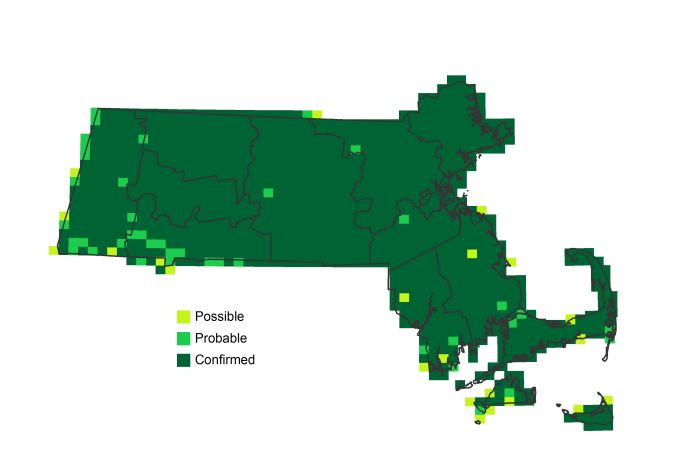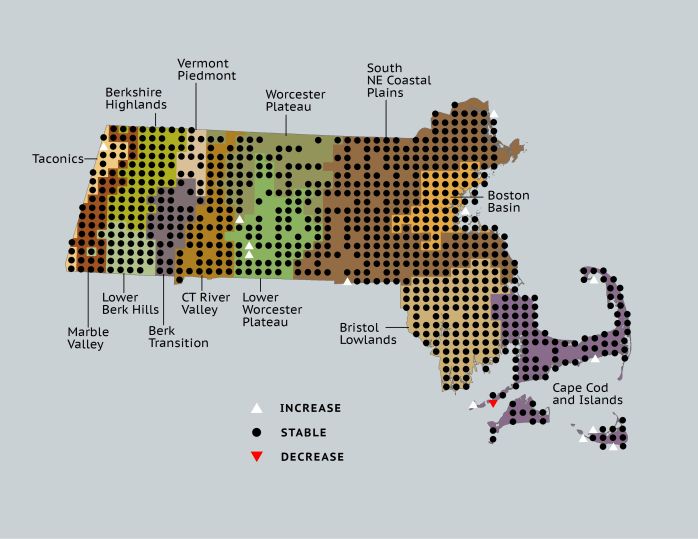Find a Bird
American Robin
Turdus migratorius

Nearly ubiquitous and stable
Action/monitoring needed
“A robin redbreast in a cage / Puts all heaven in a rage.” – William Blake, “Auguries of Innocence
Seen regularly in city parks, on suburban lawns, and in forest clearings, American Robins may be the most familiar bird in North America. Even the most jaded city dweller can identify the robin and appreciate the beauty of its cheerful caroling. The return of robins to their breeding grounds is synonymous with the beginning of spring in the minds of many, although many American Robins now spend the winter in Massachusetts. Our largest thrush is also unquestionably our most successful, breeding from the Berkshires to Nantucket and everywhere in between. We do note a drop in this species’ abundance, however, making this yet another whispering decliner.
Historic Status
“If every robin should produce five young each year,” warned Edward Howe Forbush, “and each robin should live fifteen years, in time every square foot of land on this continent would be packed with robins,” (Forbush 1907). While Massachusetts has never reached that level of American Robin saturation, the bird has been ever present in the records. Abundant in summer, they have long been known to overwinter in the state in varying numbers, a trend that is increasing (Mass Audubon 2011). Winter counts of robins have climbed consistently in recent years, possibly due in part to warmer winters.
Atlas 1 Distribution
As befits a species that is arguably the most widely recognized bird in the nation, the American Robin was nearly ubiquitous in Massachusetts during Atlas 1. Throughout western Massachusetts, breeding robins were found in every single block, except for one in the Taconic Mountains. The dense forests and open water of the Quabbin area, at the interface of the Worcester and Lower Worcester Plateaus, marked a clear gap in robin distribution. Additional scattered blocks where no robins were found in the Lower Worcester Plateau and the Coastal Plains may have been genuine misses or a result of poor coverage in Atlas 1. In the rest of the state, robins were absent only in those areas of the Boston Basin and Cape and Islands that consisted of treeless isles where robins could not nest.
Atlas 2 Distribution and Change
Robins persist as one of our most widespread breeding birds, with the notable statistic that, when using the effort-controlled data, there is only one block in the state where they were found in Atlas 1 and missed in Atlas 2. They are easy to identify, easy to detect, and often one of the first birds to be Confirmed as a breeder on a day in the field.
Atlas 1 Map

Atlas 2 Map

Atlas Change Map

Ecoregion Data
Atlas 1 | Atlas 2 | Change | ||||||
Ecoregion | # Blocks | % Blocks | % of Range | # Blocks | % Blocks | % of Range | Change in # Blocks | Change in % Blocks |
Taconic Mountains | 15 | 93.8 | 1.6 | 23 | 92.0 | 2.3 | 1 | 6.7 |
Marble Valleys/Housatonic Valley | 39 | 100.0 | 4.2 | 39 | 100.0 | 3.9 | 0 | 0.0 |
Berkshire Highlands | 55 | 100.0 | 5.9 | 55 | 100.0 | 5.4 | 0 | 0.0 |
Lower Berkshire Hills | 28 | 100.0 | 3.0 | 30 | 96.8 | 3.0 | 0 | 0.0 |
Vermont Piedmont | 17 | 100.0 | 1.8 | 17 | 100.0 | 1.7 | 0 | 0.0 |
Berkshire Transition | 38 | 100.0 | 4.1 | 40 | 100.0 | 4.0 | 0 | 0.0 |
Connecticut River Valley | 56 | 100.0 | 6.0 | 65 | 100.0 | 6.4 | 0 | 0.0 |
Worcester Plateau | 75 | 96.2 | 8.1 | 88 | 100.0 | 8.7 | 1 | 2.1 |
Lower Worcester Plateau | 67 | 90.5 | 7.2 | 80 | 100.0 | 7.9 | 2 | 3.7 |
S. New England Coastal Plains and Hills | 265 | 98.1 | 28.5 | 280 | 98.9 | 27.7 | 2 | 0.9 |
Boston Basin | 53 | 94.6 | 5.7 | 55 | 98.2 | 5.4 | 1 | 1.8 |
Bristol and Narragansett Lowlands | 105 | 99.1 | 11.3 | 113 | 99.1 | 11.2 | 0 | 0.0 |
Cape Cod and Islands | 116 | 85.3 | 12.5 | 127 | 88.2 | 12.5 | 5 | 4.2 |
Statewide Total | 929 | 95.9 | 100.0 | 1012 | 97.6 | 100.0 | 12 | 1.4 |
Notes
The American Robin shows a significant decreasing Breeding Bird Survey (BBS) trend in Massachusetts and the New England/Mid-Atlantic Region, but a significant increasing BBS trend in the Eastern US overall. They fall into our “whispering bird” category – those species with a demonstrated stable or increasing breeding footprint from Atlas 2 data, but also a demonstrated decline in abundance from the BBS. This drives our final assessment that this is a species with a need for further monitoring, and conservation action.



